Salmon 385. Part 3 – There were three segments in the final leg of our 385 mile trip in the Salmon and Snake River basins. In Part 3 Janene and I rowed 90 miles down the Main Salmon, 60 miles along the Riggins reach of the Salmon, and finally 70 miles on the Lower Salmon and Snake.
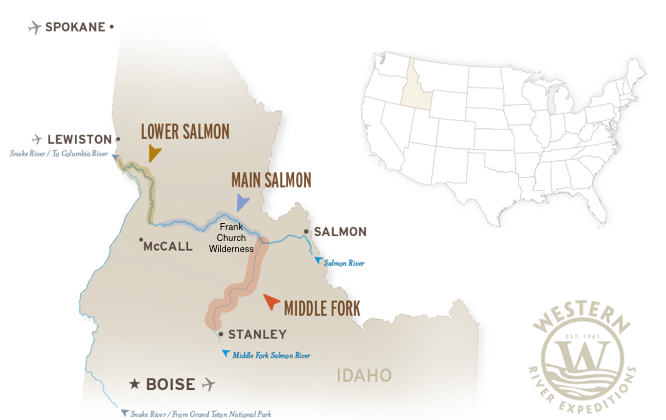
What, you missed parts 1 and 2? Fear not. You can get all caught up.
Salmon 385. Part 1 – Janene and I rafted 100 miles down the Middle Fork of the Salmon River in seven days. Read about that at Moby Goes Salmon 385 (Part 1 of 3)
Salmon 385. Part 2 – Our second leg was a 70 mile backpack in the Frank Church River of No Return Wilderness. Read about that Moby Goes Salmon 385 (Part 2 of 3)

The confluence of the Middle Fork and Main Salmon is at a 90° angle, so rather than ending a trip after floating the MF you can just “turn the corner” and continue on down the Main. The only problem is that both rivers require lottery-won permits. A Boise friend invited us on his MF permit, and my niece invited us on her Main permit, enabling us to turn the corner. But we had backpacked for a week to kill time between permits, so it was a slow turn. Many rafters dream and talk of turning the corner, but I don’t think I’ve personally know anyone who pulled it off.
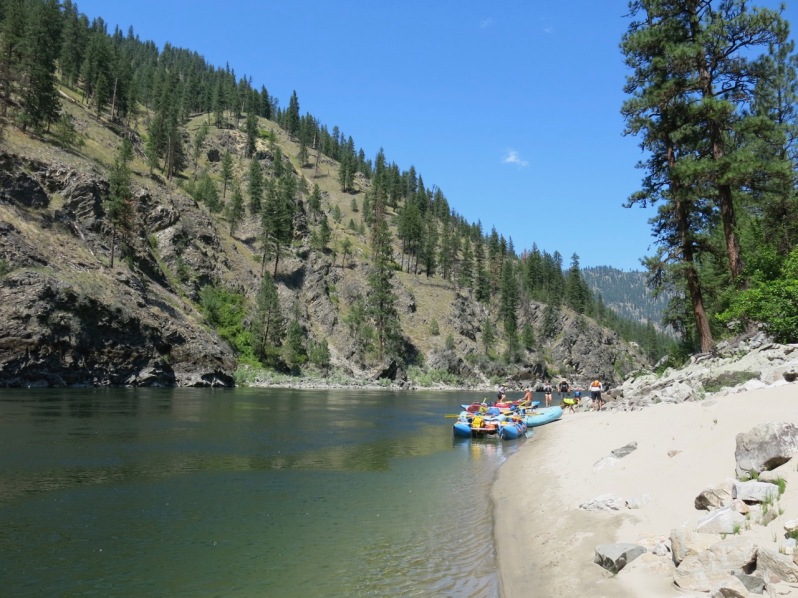
Twice the size of the MF, the Main has warmer water and way more sandy beaches, but fewer trout and less whitewater. I love both rivers, and have now floated nine times down MF and eight on the Main.

Jack and I go all the way back to middle school. We played ball, hunted, and fished together back in the day. He even helped hook me up with my first ex-wife. Years later I had his two fine kids in my classroom. We have long talked of doing an Idaho river trip together, and it finally happened here in 2016.

Luckily we haven’t aged a bit since our freshman year in 1970.

Jack is a renowned fishing guide in the Portland area. I got a kick out of guiding him a bit here on the Main. But he didn’t catch a thing while I was on the oars! You can’t hire me, but you can sign up with Jack in Oregon at http://hookupguideservice.com/

While the whitewater on the Main is not continuous, there are plenty of rapids such as Elkhorn here that are worthy of scouting.

No Main Salmon trip is complete without a stop for ice cream at Buckskin Bill’s. Leaving engineering school, Bill chose the hermit’s life during the Great Depression and built a life here in the remote canyon. He also built a fort (upper left) to keep the federal government tax collectors at bay if need be.

Bill hunted, gardened, and panned enough gold to get by. He was a mechanical genius who hand-crafted his own guns. But the only invasion that ever came was in the 1960’s as the whitewater rafting boom took off and spoiled his solitude. After Bill’s death, a German couple arrived in the canyon on horseback (that’s another story), became caretakers of his place, and now maintain a museum about his life. Heinze and Barbara pan gold from tourist wallets now, not from the stream gravels. Boaters are willing to pay a lot for ice, cold beer, and ice cream in the middle of the wilderness.

Vinegar Rapids marks the end of most float trips on the Main. But our group was in no hurry, so we passed the take-out ramp and kept on going.

Lehua came all the way from Hawaii for a good time on the river. She is a big promoter of dress-up themes in camp, but this day she sported some dayglow colors while on the sticks. What would Buckskin Bill have thought?
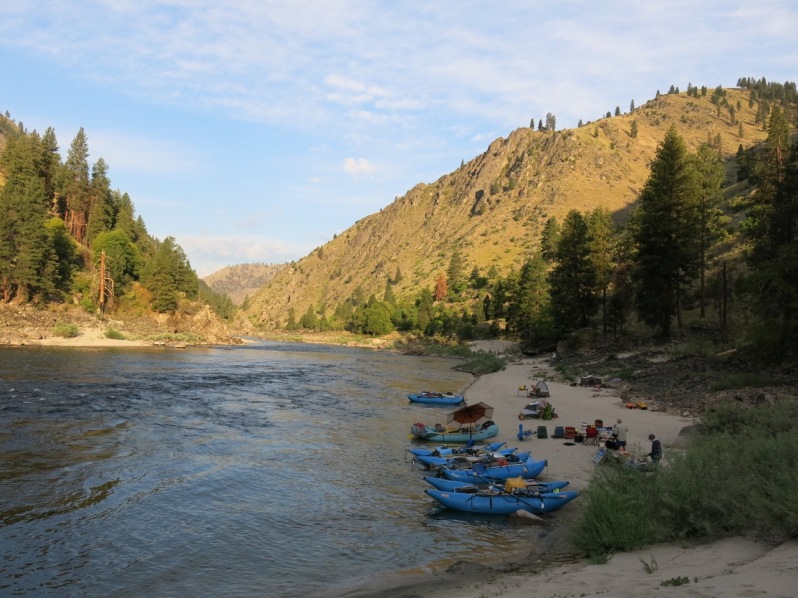
Blazing July sun finally setting, our Main Salmon pals make their last camp near Robbins Creek. Cable Car hot springs sits a mile up the hill, but in the heat there was not much enthusiasm for a hot soak.

Janene and I have done so many trips of all kinds that we have the whole planning and packing thing down pretty well. But this trip posed a new challenge, as it was really five trips in one. We could not carry 33 days worth of stuff all at once. No point in carrying a backpack down the river. I had to create a chart to keep track of which gear was needed on which part of the trip, and which pals would haul away or deliver what stuff where. Janene thought the food planning was critical, but for me ice, beer, and fishing gear were big concerns. Warm water bass and mountain trout each require special gear. A trip without cold beer in the raft by day and icy cocktails in the evening camps is a serious hardship.

After eight days and ninety miles our Main Salmon crew drove off with all our garbage and extraneous gear. For the next three days Janene and I floated solo sixty miles between the two sections commonly known as the Main and the Lower Salmon. Below Riggins, on this stretch along Highway 95, there are a handful of really good rapids that support the town’s rafting day trip industry. But once below that it flattens out and we had the river to ourselves.

As is so often the case, the non-wilderness proved to be much less crowded than the official wilderness rivers. We found perfect sandy beaches like this one without a single human footprint on them. Perfect for what Janene and I call “black tarp camping”, we just spread out our little black tarp and sleep under the stars.

Why is Hannah grinning? Because she made it to the Lower Salmon River here at the Hammer Creek put-in before dark. A pal to daughters Nat and Katie in Austin, TX (not an area known for whitewater rafting), we have taken them all rafting with us in the past. Hannah wanted to join us this year, but with our our epic journey we told her if she wanted to go she would have to make it happen on her own. So she did. She flew to Eugene, OR, teamed up with her buddy Ethan and drove to Walla Walla, WA where they got a rental raft, drove on to Whitebird, ID and met up with us. A perfectly executed plan.

Nature’s diving board.
 Bounty from the Lower Salmon. My fishing guide Janene always oars me to the best spots, whether for trout up in the high country or these smallmouth bass down low. In the course of our 315 river miles we dropped from 6,280′ elevation down to 830′. And no, the colors in this photo were not enhanced. The bass really are that greenish yellow, and I really was that red.
Bounty from the Lower Salmon. My fishing guide Janene always oars me to the best spots, whether for trout up in the high country or these smallmouth bass down low. In the course of our 315 river miles we dropped from 6,280′ elevation down to 830′. And no, the colors in this photo were not enhanced. The bass really are that greenish yellow, and I really was that red.
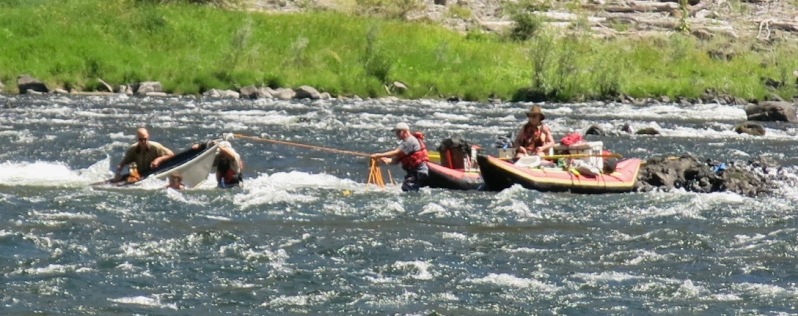
Unlike Janene, these clowns did not know how to row. They had managed to sink their aluminum drift boat in a minor rapids. They were clueless as to what to do next, and their whole party was just standing around when we showed up. Luckily for them, this was not the first rodeo for Keith (sitting) and me (wrestling the front of the drift boat). In fact, Keith is older than the Appalachians, and it is said by some that his beloved red, yellow, and black raft “Dolly” first saw service on Noah’s Ark. It took a while, but we came up with a plan, Keith rowed us out to their wreck, and we got it off the bottom and floating again. Did they thank us? Barely. Did they offer us some beer in payment? No, sadly. When they and the other boats in their party passed us a couple days later did they all avoid eye contact and row by us without so much as a wave? Yes, incredulously.

Party time. Not sure what the dress up theme was this night, but Ethan and Hannah lit up the kitchen while putting my bass fillets to good use in their tasty Thai meal. On these river trips such a cooking team does all the prep, cooking, and cleaning for one dinner and one breakfast, and then the rest of the trip you just get to sit back and take it easy.

Here on Hawaiian night, Keith and Becca have the “sit back and take it easy” part of this Lower Salmon trip down to perfection.

Kazakhstan BVD’s meet Zombie apocalypse? Who knows what theme Marty was going for this dress up night.

Even a river goddess grandma needs her afternoon nap. By Day 32 Janene had perfected her shade technique, as demonstrated here at China Garden beach.

Our last camp was at a beach just upstream of China Garden Creek Ranch. Gold was discovered in this part of Idaho in 1860. Until then Idaho was considered nothing but worthless desert laced with mountainous terrain only to be endured while you passed through on the way to someplace better. Many travelers on I-84 still feel that way, I suppose. But the discovery of gold brought an influx of miners; predominantly destitute Oregon farmers, disillusioned ex-Confederate deserters, and Chinese immigrants. Chinese miners at this creek grew vegetables to eat and to sell to the white miners. The local whites regularly repaid the Chinese with assault, robbery, murder, and even mass killings. No whites in these parts were ever prosecuted by their jury of peers. By 1870, the non-Indian population of Idaho was about 18,000, of which almost 5,000 were Chinese. Violence and discriminatory legislation, such as a monthly tax levied on all Chinese in Idaho, led to most Chinese leaving the state.

For an account on the worst of these atrocities check out this book by R. Gregory Nokes, a retired reporter at the Oregonian newspaper.
Or at least read a quick summary of the book at http://www.massacredforgold.com/index.html
Funny how this sort of thing was not covered when I learned Oregon history back in 6th grade. It is part of what made America great, right?
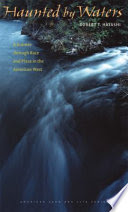
For an interesting look at more such cheery bits of western race relation history and how it continues to affect our modern lives, check out Haunted by Waters: A Journey Through Race and Place in the American West, by Robert T. Hayashi.
You can preview this book free on Google Books at https://books.google.com/books?id=-DgWipafkScC&printsec=frontcover#v=onepage&q&f=false
 Those Confederates who settled central and northern Idaho? Their descendants and anti-federal government attitudes are still here. We have yet to drive Moby through the Deep South. But in all of Moby’s travels there are three places where we have seen a cluster of Rebel flag displays: eastern Texas near the Louisiana border, eastern Arizona, and central Idaho. And this was before Trump was elected. The day after the election I saw my first Rebel flag flying from a big pickup (not this one) in Boise. Coincidence?
Those Confederates who settled central and northern Idaho? Their descendants and anti-federal government attitudes are still here. We have yet to drive Moby through the Deep South. But in all of Moby’s travels there are three places where we have seen a cluster of Rebel flag displays: eastern Texas near the Louisiana border, eastern Arizona, and central Idaho. And this was before Trump was elected. The day after the election I saw my first Rebel flag flying from a big pickup (not this one) in Boise. Coincidence?

Back to our river story .The easy way to get to China Garden Creek Ranch, or to see Hells Canyon, the deepest canyon in North America, is on a jet boat tour from nearby Lewiston, ID. The ranch is now owned by The Nature Conservancy, and the buildings of the once working ranch are now used to host retreats, accommodate private guests, and to serve lunches to boatloads of day trippers. Sign up for a ranch visit at http://snakeriveradventures.com/garden-creek-ranch/

Night 32 here on the Snake River at China Garden Creek. Our last black tarp camping night.

Behind the group here on China Garden beach is State Line Creek, the border between Oregon and Washington. Oregon to the left, Washington to the right, in case you can’t tell by looking.

Salmon 385
33 days, 315 miles by raft (of which Janene likely rowed more than 300 miles) and 70 more on foot. I’ve discussed such a trip with rafting buddies for decades, but I never really thought it would happen.
Nor did I ever dream I would have such a partner with which to do it.
Time to keep dreaming big.
Holy cow, what an amazing journey! I just ordered Haunted By Waters, and another book by Nokes (Breaking Chains). Thanks for opening these new channels.
Howdy: thanks for letting us know and see your floats in such scenic terrain and rivers. Love, Dad and Mom